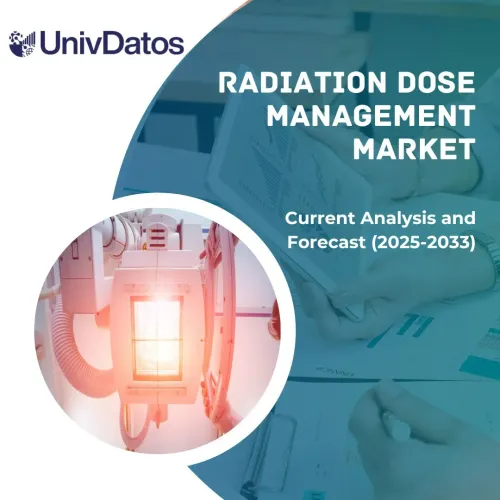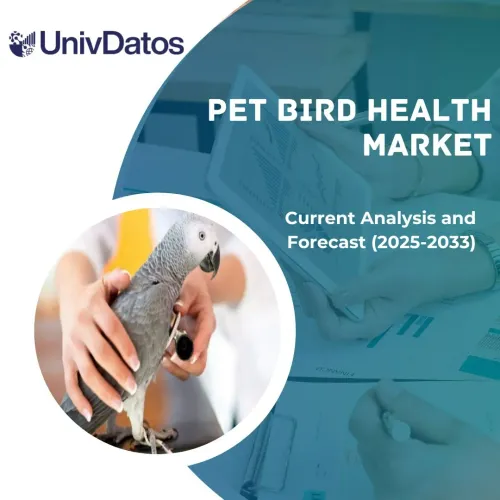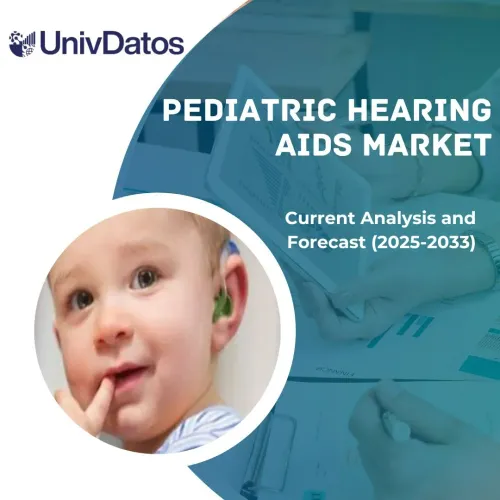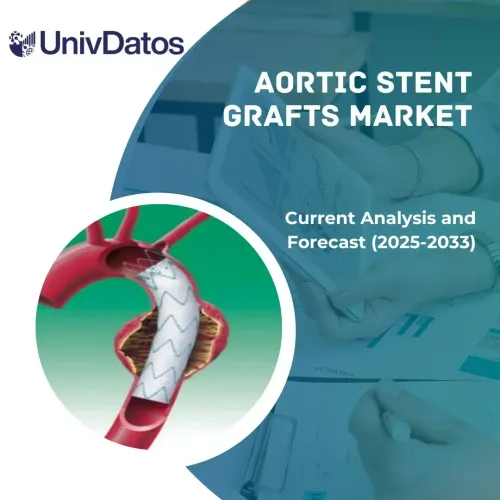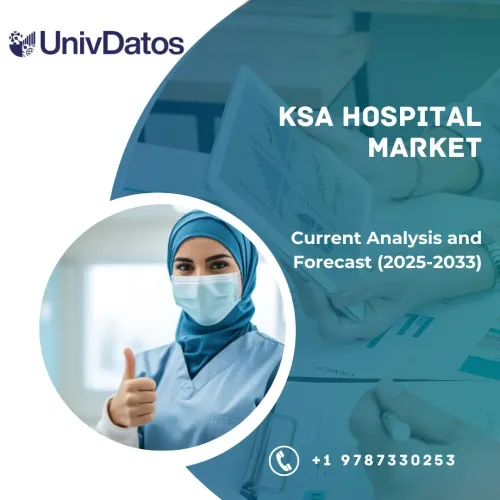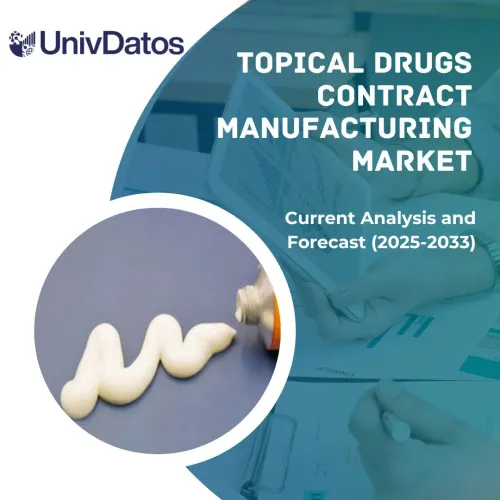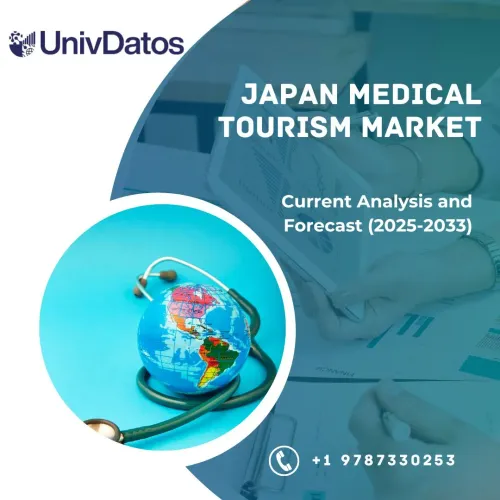- Home
- About Us
- Industry
- Services
- Reading
- Contact Us
Artificial Blood Vessels Market: Current Analysis and Forecast (2021-2027)
Emphasis on Polymer Type (Polydioxanone, Elastomer, Polyethylene Terephthalate, Others); Application (Aortic Disease, Peripheral Artery Disease, Hemodialysis); End-Users (Hospitals, Cardiac Catheterization Laboratories, Ambulatory Surgical Centers, Specialty Clinics, and Others); Region/Country
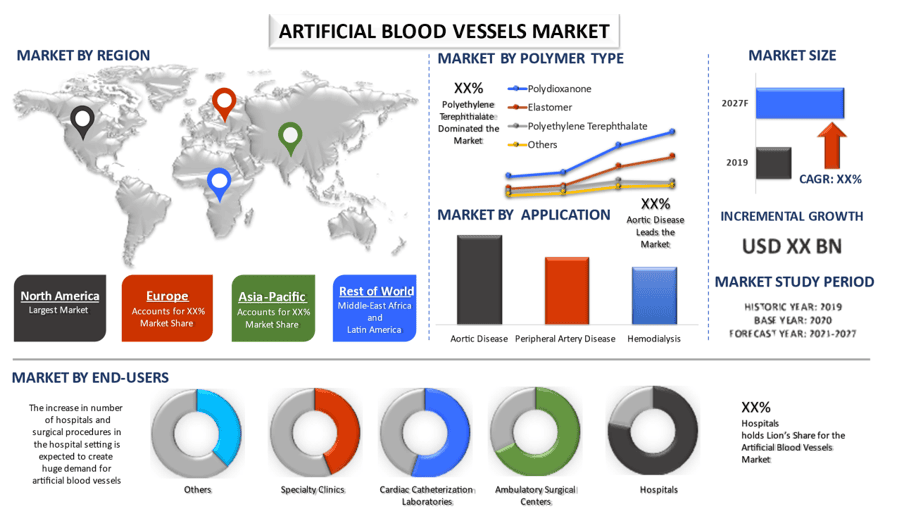
Global Artificial Blood Vessels Market is anticipated to grow with an elevated CAGR of around 5% over the forecast period (2021-2027). Artificial Blood Vessels are tubes made up of various synthetic materials that are mainly used to substitute damaged blood vessels which may result in fatality. Biopolymers such as polydioxanone and polyethylene terephthalate are more commonly used for making artificial blood vessels owing to their mechanical properties like high resistance against water and chemical, high oxygen permeability, and high conductivity.
The growing adoption of artificial blood vessels can be attributed to the rising prevalence of various cardiovascular diseases coupled with a rapidly growing geriatric population. According to the United Nations, the 60+ aged population was 962 million in 2017 which is more than twice that it was in 1980 at 382 million. The number of elderly is expected to double again by 2050 and reach nearly 2.1 billion worldwide. The occurrence of cardiovascular diseases is almost 15% higher in the elderly population as compared to the younger population and the increase in this population is expected to increase the number of cardiovascular diseases around the world. Thereby, boosting the artificial blood vessels market globally.
Furthermore, the artificial blood vessels market is anticipated to grow on account of the growing technological advancement, a large number of ongoing research activities in this field, rising government and public-private investments, and various advantages associated with the implementation of artificial blood vessels. Some of the benefits include favorable reimbursement policies, prevention of blood coagulation when in contact with blood, and high resistance to some infections coupled with the healing, contracting, and the ability to secrete byproducts same as that of natural blood vessels. However, some of the restraints in the market including stringent regulatory framework and high costs associated with transplants and surgeries are impeding the growth of this market all over the world.
Cardiovascular Disease (CVD): The World’s Number 1 Killer

- Braun Melsungen, Becton, Dickinson and Company, Cook Medical Incorporated, Medtronic, LeMaitre Vascular Inc., Terumo Medical Corporation, W. L. Gore and Associates, Jotec GmbH, Humacyte Inc., Techshot Inc., are some of the prominent players operating in the artificial blood vessels market. Several M&As along with partnerships have been undertaken by these players to facilitate customers with artificial blood vessels.
Insights Presented in the Report
“Amongst Polymer Type, polyethylene terephthalate segment holds the major share”
Based on polymer type, the artificial blood vessels market is segmented into polydioxanone, elastomer, polyethylene terephthalate, and others. The polyethylene terephthalate segment accounted for a significant market share in 2020 and it is estimated that it will grow rapidly during the projected timeframe as these are biostable polymers that are currently being used as the standard biomaterials for vascular grafts in various clinical applications. This biomaterial has been widely used in humans since the 1970s as it performs well as large-diameters blood vessel grafts (>6 mm).
“Amongst Application, aortic disease segment holds the major share”
Based on application, the artificial blood vessels market is divided into aortic disease, peripheral artery disease, and hemodialysis. The aortic disease segment occupied the major share of the artificial blood vessels market in 2020 and it is expected to grow with a substantial CAGR in the upcoming years. The growth of this segment is attributed to the increasing prevalence of various medical conditions and diseases that can cause damage to the aorta and put patients at life-threatening risk. These medical conditions include atherosclerosis, genetic conditions, connective tissue disorders, hypertension, etc. For instance, as per the World Health Organization, nearly 1.28 billion adults aged between 30-79 years have hypertension across the globe. However, the hemodialysis segment is also expected to grow considerably during the projected timeframe owing to the increase in the number of people suffering from chronic kidney disease.
“Amongst End-Users, hospitals segment holds the major share”
Based on end-users, the market is fragmented into hospitals, cardiac catheterization laboratories, ambulatory surgical centers, specialty clinics, and others. In 2020, hospitals segment grabbed a considerable market share, and it is expected to grow at a significant CAGR during the forecast period owing to the increasing construction of hospitals and a surge in the number of heart surgeries in the hospital setting. However, ambulatory surgical centers are also likely to witness the fastest growth during the forecast period.
“North America represents one of the largest markets of artificial blood vessels market”
For a better understanding of the market dynamics of the artificial blood vessels market, a detailed analysis was conducted for different regions across the globe including North America (the U.S, Canada, and the Rest of North America), Europe (Germany, France, Spain, United Kingdom, Italy, and Rest of Europe), Asia-Pacific (China, India, Australia, Japan, and Rest of APAC), Rest of World has been conducted. North America constitutes a major market for the artificial blood vessels market industry and generated revenue of USD XX Million in 2020 owing to strong healthcare infrastructure and growing adoption of artificial blood vessels in the region.
Reasons to buy this report:
- The study includes market sizing and forecasting analysis validated by authenticated key industry experts
- The report presents a quick review of overall industry performance at one glance
- The report covers an in-depth analysis of prominent industry peers with a primary focus on key business financials, product portfolio, expansion strategies, and recent developments
- Detailed examination of drivers, restraints, key trends, and opportunities prevailing in the industry
- The study comprehensively covers the market across different segments
- Deep dive regional level analysis of the industry
Customization Options:
The global artificial blood vessels market can further be customized as per the requirement or any other market segment. Besides this, UMI understands that you may have your own business needs, hence feel free to connect with us to get a report that completely suits your requirements.
Table of Content
Analyzing the historical market, estimation of the current market, and forecasting the future market of the global artificial blood vessels market were the three major steps undertaken to create and analyze the adoption of artificial blood vessels in major regions globally. Exhaustive secondary research was conducted to collect the historical market numbers and estimate the current market size. Secondly, to validate these insights, numerous findings and assumptions were taken into consideration. Moreover, exhaustive primary interviews were also conducted, with industry experts across the value chain of the global artificial blood vessels market. Post assumption and validation of market numbers through primary interviews, we employed a top-down/bottom-up approach to forecasting the complete market size. Thereafter, market breakdown and data triangulation methods were adopted to estimate and analyze the market size of segments and sub-segments the industry pertains to. Detailed methodology is explained below:
Seek More Details About Research Methodology
Analysis of Historical Market Size
Step 1: In-Depth Study of Secondary Sources:
Detail secondary study was conducted to obtain the historical market size of the artificial blood vessels through company internal sources such as annual report & financial statements, performance presentations, press releases, etc., and external sources including journals, news & articles, government publications, competitor publications, sector reports, third-party database, and other credible publications.
Step 2: Market Segmentation:
After obtaining the historical market size of the artificial blood vessels market, we conducted a detailed secondary analysis to gather historical market insights and share for different segments & sub-segments for major regions. Major segments included in the report as polymer type, applications, and end-users. Further country-level analyses were conducted to evaluate the overall adoption of artificial blood vessels across the globe.
Step 3: Factor Analysis:
After acquiring the historical market size of different segments and sub-segments, we conducted a detailed factor analysis to estimate the current market size of the artificial blood vessels. Further, we conducted factor analysis using dependent and independent variables such as growing advancement in technology and increasing prevalence of aortic diseases. A thorough analysis was conducted for demand and supply-side scenarios considering top partnerships, merger and acquisition, business expansion, and product launches in the artificial blood vessels sector across the globe.
Current Market Size Estimate & Forecast
Current Market Sizing: Based on actionable insights from the above 3 steps, we arrived at the current market size, key players in the artificial blood vessels market, and market shares of the segments. All the required percentage shares split, and market breakdowns were determined using the above-mentioned secondary approach and were verified through primary interviews.
Estimation & Forecasting: For market estimation and forecast, weights were assigned to different factors including drivers & trends, restraints, and opportunities available for the stakeholders. After analyzing these factors, relevant forecasting techniques i.e., top-down/bottom-up approach was applied to arrive at the market forecast about 2027 for different segments and subsegments across the major markets globally. The research methodology adopted to estimate the market size encompasses:
- The industry’s market size, in terms of value (US$) and the adoption rate of artificial blood vessels across the major markets domestically
- All percentage shares, splits, and breakdowns of market segments and sub-segments
- Key players in the artificial blood vessels market in terms of products offered. Also, the growth strategies adopted by these players to compete in the fast-growing market
Market Size and Share Validation
Primary Research: In-depth interviews were conducted with the Key Opinion Leaders (KOLs) including Top Level Executives (CXO/VPs, Sales Head, Marketing Head, Operational Head, and Regional Head, Country Head, etc.) across major regions. Primary research findings were then summarized, and statistical analysis was performed to prove the stated hypothesis. Inputs from primary research were consolidated with secondary findings, hence turning information into actionable insights.
Split of Primary Participants in Different Regions

Market Engineering
Data triangulation technique was employed to complete the overall market estimation and to arrive at precise statistical numbers of each segment and sub-segment of the artificial blood vessels market. Data was split into several segments & sub-segments post studying various parameters and trends in the areas of polymer type, application, and end-users of the artificial blood vessels market.
The main objective of the Artificial Blood Vessels Market Study
The current & future market trends of artificial blood vessels were pinpointed in the study. Investors can gain strategic insights to base their discretion for investments from the qualitative and quantitative analysis performed in the study. Current and future market trends were determined the overall attractiveness of the market at a regional level, providing a platform for the industrial participant to exploit the untapped market to benefit as a first-mover advantage. Other quantitative goals of the studies include:
- Analyze the current and forecast market size of artificial blood vessels in terms of value (US$). Also, analyze the current and forecast market size of different segments and sub-segments
- Segments in the study include areas of polymer type, application, and end-users
- Define and analysis of the regulatory framework for the artificial blood vessels industry
- Analyze the value chain involved with the presence of various intermediaries, along with analyzing customer and competitor behaviors of the industry
- Analyze the current and forecast market size of the artificial blood vessels market for the major region
- Major regions studied in the report include North America, Europe, Asia-Pacific and Rest of the world
- Company profiles of the artificial blood vessels market and the growth strategies adopted by the market players to sustain in the fast-growing market
Deep dive regional level analysis of the industry
Related Reports
Customers who bought this item also bought

